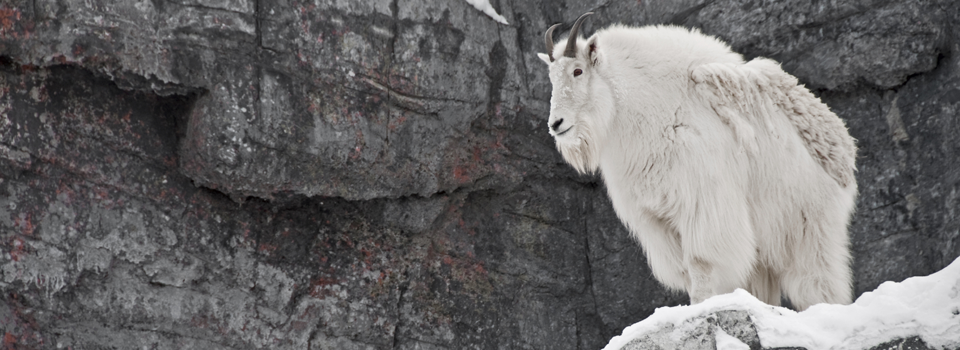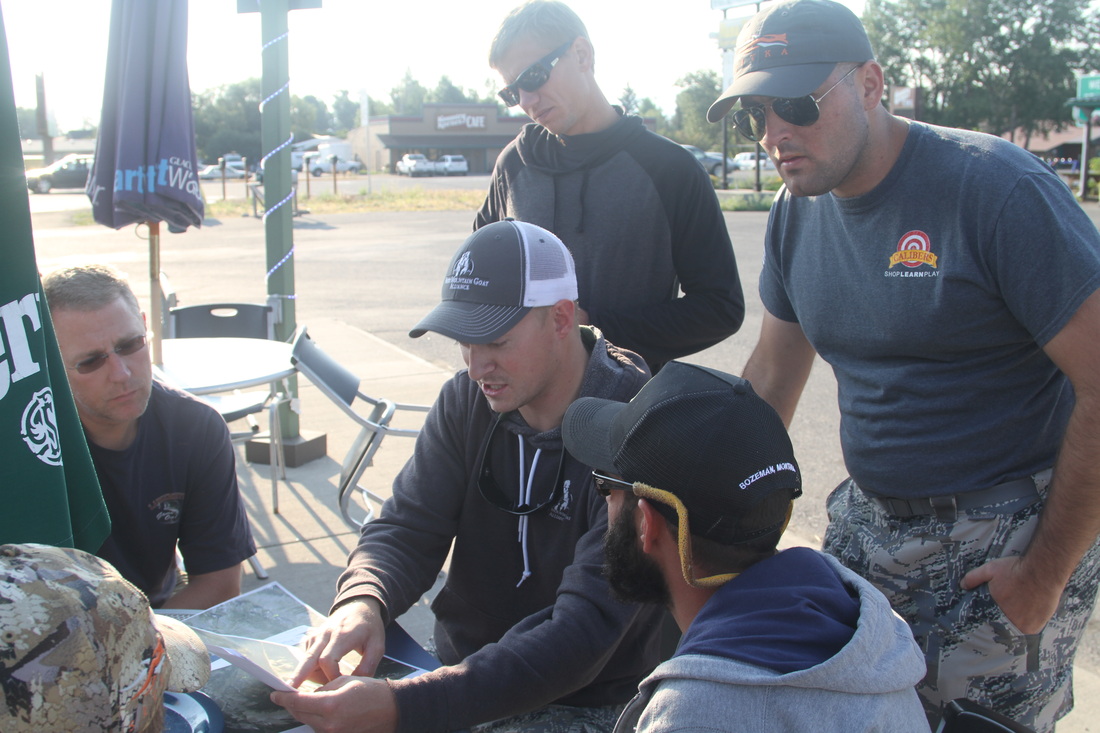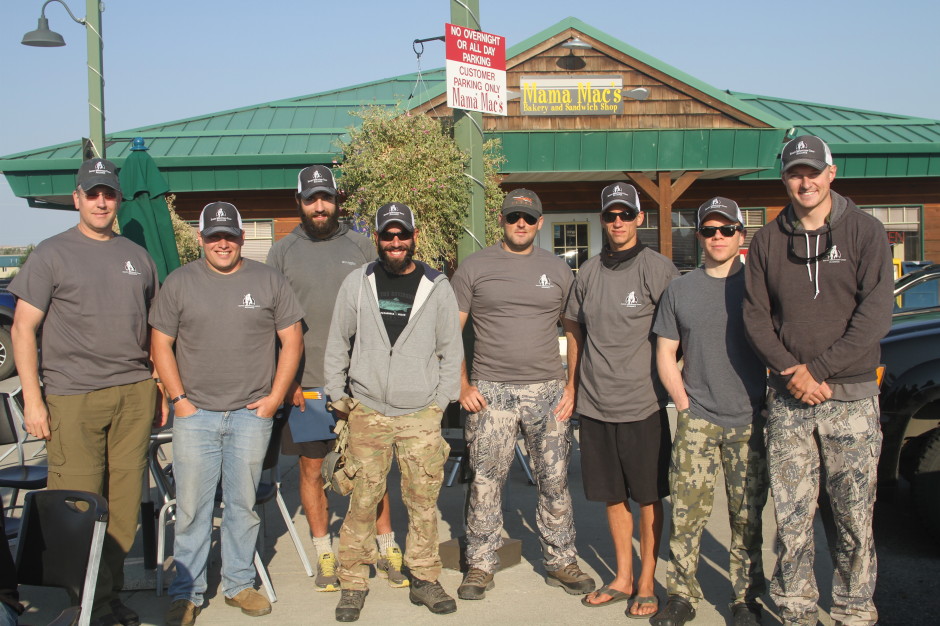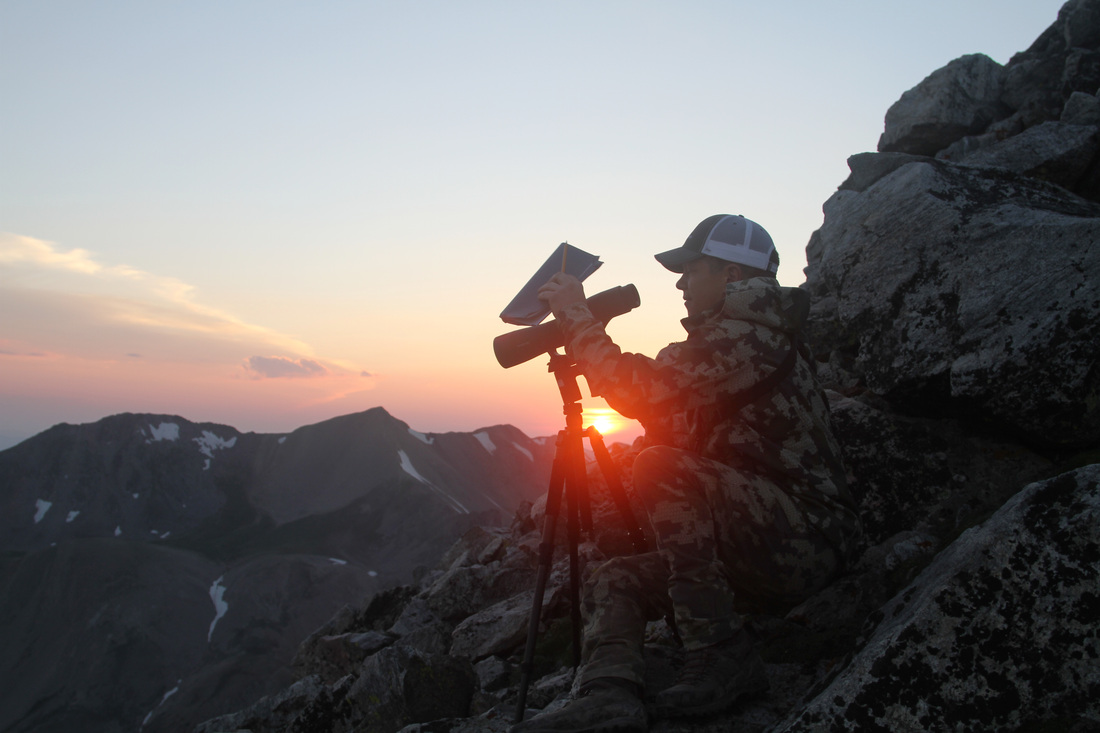The mountain hunting is community is dominated by the wild sheep of the world. Hunters travel the globe in search of mature rams, spending exorbitant sums to chase these monarchs of the mountains and hopefully join the ranks of the de facto clubs for the few that manage to achieve their “Slam”. The genus Ovis has no less than two large and powerful conservation organizations dedicated expressly to their needs and there are few species on the planet that garner as much attention or respect as the wild sheep.
But there is an animal that lays claim to even loftier heights. One that can navigate near vertical walls and cliffs that would make most sheep weak at the knees. It is the largest mammal on Earth found in the alpine, with big billys often tipping the scales over 300 lbs. Their winter coats are second only to the muskox of the Arctic for cold and wind resistance and they are without question one of the most iconic symbols of the true wild. Renowned for their toughness and resilience in habitat few animals could survive in, mountain goats nonetheless suffer from a PR problem. Often referred to as a “poor man’s sheep”, oreamnos americanus does not receive the attention it deserves in the hunting and conservation community.
But Peter Muennich is trying to change that. In 2011 he took it upon himself to help bring the rocky mountain goat into the spotlight and founded The Rocky Mountain Goat Alliance whose mission is to increase and enhance the management, range, and populations of Rocky Mountain Goats across both native and suitable non-native North American habitats and educate the public on ongoing conservation projects and petition for the expansion of sustainable hunting opportunities across the continent. Peter’s unrelenting passion for this species and his outspoken approach to conservation matters that affect them has in a relatively short period of time made waves in how we research these incredible animals and rekindled the interest of hunters and conservationists across the West.
There’s no question that Peter’s deep seeded passion for a species that needs our attention and the gumption required to spearhead a conservation organization devoted to their needs qualifies him as a “trail blazer”. If you thought you understood the Rocky Mountain Goat and more importantly the conservation needs of the “cragmaster” we guarantee this interview will open your eyes to just how little we actually know about this incredible species. If you have ever hunted or intend to hunt oreamnos americanus, we implore you to join the RMGA today and insure the future of mountain goats for generations to come: www.goatalliance.org.
Peter, tell us about the impetus behind starting the Rocky Mountain Goat Alliance?
Well it was a pretty unique chain of events. It started back in 2011, I had a mountain goat tag here in Montana and I’d always been fascinated with mountain goats. I’d spent some time up in goat country as there’s a mountain range just outside of Bozeman here that has a really healthy population. They’re fairly calm goats to be around and I had some cool experiences. Then in 2011, I had my first opportunity to hunt them and I spent a tremendous amount of time scouting and a whole lot of time hunting. I was extremely fortunate to draw that tag as I drew with only two points in Montana which is almost unheard of and over the both the pre-season and season adopted this incredible respect for the animal. I just think they’re absolutely fascinating. They’re the most capable mountain ungulate on the planet as far as I’m concerned. The country they live in and the things they’re capable of are just simply fascinating particularly for a young guy who likes climbing mountains himself. So I was truly, truly just fascinated by them for a long time. Then at Sheep Show in 2012, I watched the Montana Big Horn Sheep Governor’s Tag get auctioned off for almost a half a million dollars, $480,000. It was just mind blowing to me that that much money was being flooded into sheep conservation and sheep management off just one auction item. It was incredible to witness that much financial support come in for one species on one auction.
So when I got home, I touched base with a regional biologist, Julie Cunningham, who I’d had casual conversations with before and started to investigate whether or not there was such a thing as a “goat alliance” or anybody doing specific work for mountain goats. And the answer was basically ‘no’. Montana State has a really good mountain ungulate college program. We have Professor Bob Garret up here and there’s a lot of like minded people in the mountain ungulate conservation community – if you want to call it that – here in Bozeman. So, some of the pieces of the puzzle were there but there was no real structure to any kind of organisation and although the Sheep Foundation has goats kind of under the umbrella of their mission and purpose, they are fairly exclusively dedicated to the wild sheep of North America.
After a little more investigation, I just kind of tackled it myself. In the beginning it was nothing more than a Facebook page and conversations with our State Biologist on how to get involved and how and where we could help mountain goat management. And sure enough there was a need for some help. They’re a fairly mysterious species. Julie (Cunningham) set us up with our inaugural project right on day one when she informed us they had a recently discovered population of mountain goats on the Idaho/Montana border that nobody had been able to survey. They knew nothing except that they’d been spotted in that vicinity. So we were turned loose on doing a “citizen-scientist” based mountain goat survey – right there in our infancy – and it was a total success. We backpacked – there was a group of three of us – so we’ve grown quite a bit since then but there were only three of us at the time and we were kind of delegated this responsibility to go into this unmapped goat country and record what we could find. So we spent a couple of days up in the back country of this pocket of the south tip of the Madison Range on the Idaho/Montana border and we found this booming population of mountain goats. And it was just mind blowing to us that this robust goat population had been flying under the radar. Who knew how long they’d been in there?
The assumption was they likely migrated from the North from the Madison Range further up in Southwest Montana, crossed the Madison River at some point and climbed up into this new pocket of the mountain range. It was incredible. In one weekend, we documented almost sixty mountain goats up there. We managed to get them all on film, and took photos and GPS coordinates and documented everything as thoroughly as possible and turned everything over to Montana Fish, Wildlife and Parks. Fast forward a year and a half later, and Fish Wildlife and Parks opened the area up to hunting. There were two tag holders in there this year who both took extremely mature, beautiful billies out of there.
And if we understand correctly, you accompanies one of these tag holders on their hunt?
I actually went on both of them! I was fortunate enough to get invited along with these guys because those tag holders had reached out to Fish, Wildlife and Parks to investigate the area a little bit and they passed them on to me. So I ended up talking to them quite a bit over the season. Super nice guys. One non resident, one resident. Really, really cool people and I was lucky enough to be invited along. That was a huge victory for us and it was just a monumental thing to accomplish at such an early stage in the life of the RMGA. On the other end of that spectrum however, here in Montana, we’ve since organized other volunteer survey projects that resulted in the closure of mountain goat hunting opportunities.
Yes, we saw that in one of the membership emails. Tell us more about that specific situation.
Mountain goats are a really mysterious animal in a lot of different ways, one of the most concerning situations is we just don’t have a lot of answers for their decline in certain areas. And that’s a high priority for the Goat Alliance, to assist in that kind of research. But as far as immediate action is concerned, some of these hunting districts need to be dialed down a little bit. So we have an area, District 326 in Montana, that sustained excessive nanny harvest for quite a while and then after this excessive nanny harvest, general harvest success rates in the unit dropped significantly.
Both of those are pretty good indicators that the population might not be doing well. So we went and surveyed the district because it’s an area with six tags every year, and we counted twenty one goats and we had three volunteer teams spread out across probably a hundred square miles so we covered the country pretty thoroughly. And this was startling news to Montana Fish, Wildlife and Parks who we worked really closely with. They were immediately concerned by this report and got their team into an airplane 24 hours after we got out of the woods. They did an aerial survey to follow up on our ground based survey and they only found twelve goats. I have to add, we were pretty proud of ourselves for having a more thorough survey through our volunteer ground-based effort than a super expensive plane or helicopter was able to achieve!
That project really shined some light on the fact that some mountain goat populations and districts can go unmanaged for only a couple of years and then things can change very quickly. The mountain goat is such a unique animal as far as population dynamics, reproductive rates, survival rates are concerned. It’s not a whitetail deer! We need to pay close attention to population numbers, conduct ground based surveys when budgets don’t allow aerial surveys to occur and watch harvest statistics, especially as it relates to nannies very closely.
It’s amazing when you look at some of these regions and see how little information we really have on these incredible animals. They get very little attention when compared to wild sheep or even elk.
Yeah, absolutely. There is just such a lack of general public interest in this species and we’re trying to change that. But when it comes down to it, the same calibre of research is not being done on these animals as on wolves and elk, or big horn sheep, or even mule deer. The mountain goat, in part because of where it lives but also due to a downright lack of understanding and interest, remains slightly mysterious even to the biologists tasked with monitoring them let alone the average hunter.
The money follows the public interest and if you’re selling a half a million dollar big horn sheep tag, you’ve got some money to do some sheep research. And if you sell your mountain goat Governor’s tag every year for $9,000 to $16,000 you don’t have as much. So, the reality is there are financial or budgetary restraints that play into this situation as well. That’s not to throw the biologists under the bus, everyone has a budget so that’s understandable but there’s no question we need to do more to support mountain goat conservation.
What’s interesting about this whole financial piece is that you and the other volunteers have shown that other than a little bit of sweat and time, it doesn’t necessarily require large expenditures to get the data some the basic data we need. In fact it might even be better to just get boots on the ground and research some of these areas from that perspective.
Absolutely. The number one thing we hear when we discuss the issue with State officials is that they need boots on the ground. They need hands to help and eyes on hills. We’ve proven that these ground-based surveys are a thorough way to document some of these populations. When you add in the fact that an aerial survey can put significant stress on a population of goats hanging on to the edge of a cliff it just makes sense to do more of these basic, inexpensive surveys.
There’s no question that makes sense! Let’s move on to the mountain goat gender identification issue. If you look at most Provinces or States where goats are huntable, tags are almost always offered as “either sex” licenses yet hunters are strongly encouraged to harvest a billy. From what you know, or have been told, what is the rationale behind not simply restricting the licenses to billys only?
Gender identification is one of the biggest threats to the mountain goat population. Excessive nanny harvest has a highly negative impact on mountain goat populations and one of the most significant contributors to the demise of many populations. There are a couple issues with restricting the tags to billys only however. Lack of education or resources available to these tag holders is partly to blame. There is some information out there from a couple State Wildlife Departments that independently published their own educational pieces and some people are doing it pretty well. Utah and Alaska produced some good educational materials but the book needs to be rewritten. It’s almost 2015 and we need to make this kind of education highly digestible and more streamlined for the people that are going out and ultimately making the decision on which goats to kill.
So, to circle back to your question, I think you can’t change all these tags to billy tags for a couple of reasons. One of them being you can’t criminalize the twelve year old kid who draws a tag and can’t tell the difference between mountain goats at 300 yards. You’re never going to be able to criminalize that kid. So, because it’s so hard a lot of States and Provinces have “either sex” tags but nearly everyone strongly encourages hunters to take an old billy. Of course, both the social and ecological repercussions of shooting a ten year old billy are far less intense than shooting a three year old nanny. From a management perspective we need to look at States like Alaska that monitor nanny harvest. When nannies are shot, they (Alaska Department of Fish and Game) are directly adjusting their quotas the following year. This puts pressure on the tag holders to do their part and be educated on gender identification so they make the right decision in the field. It’s a highly effective approach, as they’re putting the accountability square on the shoulders of the hunters and directly affecting hunter’s opportunities the following year when nanny harvest statistics are not acceptable.
Exactly. Alaska, refers to this as a double quota system and it sounds like an excellent approach to goat management. In Alberta they use a “weighted system” where nannies are assigned a certain number of points and only a certain number of points are allowed to accumulate within the unit or area within the year. From an RMGA standpoint, do you feel this is the most appropriate approach to management?
Yeah, that’s just really good, in depth management. It’s proactive but not completely restrictive to the point of entirely excluding nanny harvest from the picture. It allows game managers to be proactive with the information they’re getting, and allows them to take immediate action and adjust quotas. Without this type of management, we run the risk of history repeating itself and losing population numbers. I think the educational materials available to today’s mountain goat hunter desperately need to be re-authored. And that’s a project we are just beginning to spearhead.
That was going to be our next question. An updated, modern educational package seems to be the exact project the RMGA should be the driving force behind?
It’s definitely on our “to do” list here. We’re just starting to orchestrate the pieces of the puzzle for getting it done but the end goal is to have an extremely educational, extremely digestible piece of educational media that will ultimately end up likely being a short film that can be circulated across the entire continent and even around the world. That means goat education is as available and applicable to a tag holder in Nevada, as it is in Alaska and British Columbia. It gets everybody on the same page as far as understanding the gender identifiers, but also understanding the repercussions of what happens after you pull the trigger when a nanny is killed.
A lot of hunters have hunted deer and elk their whole lives and many of them will happily shoot a doe or a cow for the meat and think nothing of it. And there’s nothing wrong with that! But generally speaking, elk and deer populations are fairly robust and they reproduce incredibly well but the mountain goat is just different and you can’t blame hunters for not knowing that goats are a very sensitive species so I think we need to raise the level of awareness for the general tag holders.
That’s an interesting point, many hunters profess to be “meat hunters” and even expressly avoid anything to do with “trophy” education not realizing that a trophy is the one animal a given population can sustain the killing of. But they will assume that since it’s legal to shoot a nanny and to them they’re just harvesting meat they can go ahead and shoot one. As hunters we have a higher obligation with some species to be more hunter-conservationists let’s say than simply hunters. As a group we need to hold ourselves accountable to a different code with the more sensitive species don’t we?
Well said, yeah, absolutely. There are a couple States that are getting more and more in depth with their documentation of harvested goats. I think Wyoming photographs every mountain goat now so they, in fifty years from now, are going to have this unbelievable archive of every goat that’s been harvested in that State.
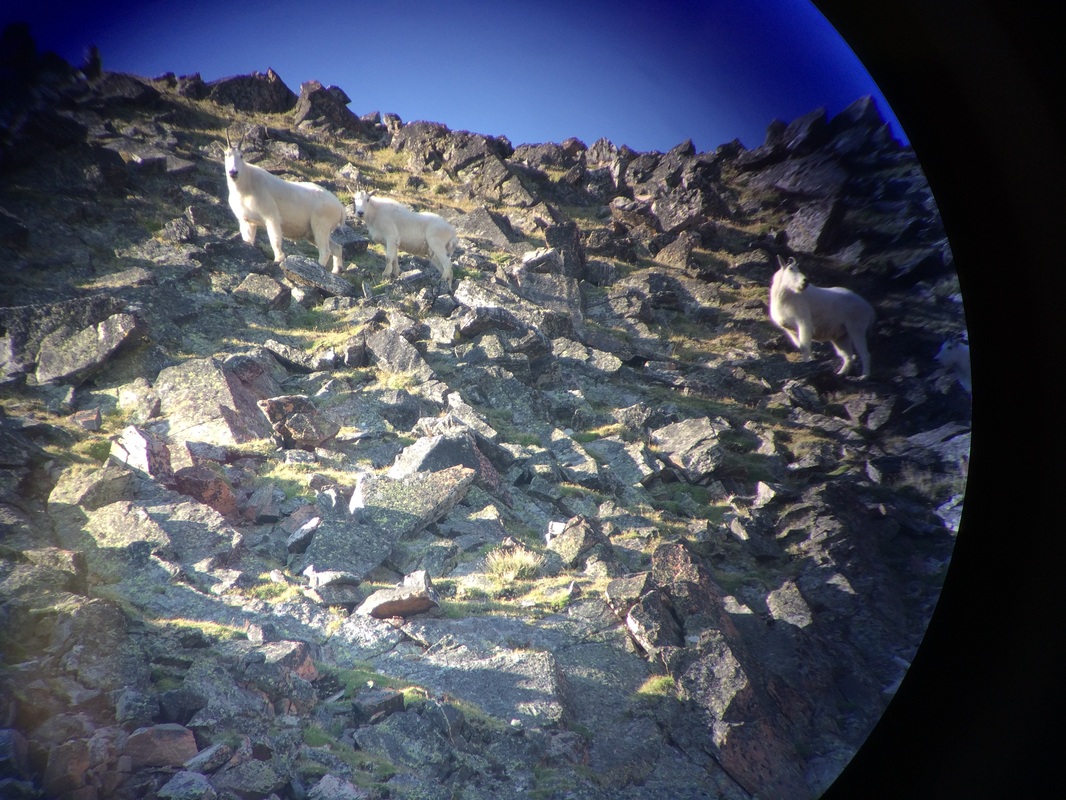
But if you think about it, if 30% to 50% of the sheep tags were used on ewes and lambs, the sheep community would be up in arms, but this is the dilemma the mountain goat faces. They are just so difficult to gender identify for the average hunter. It’s definitely one of their biggest downfalls.
As you said Pete, the educational piece is where as an organization the RMGA can have the biggest impact on those harvest stats and the future of mountain goats in North America. And as hunter-conservationists we need to be accountable for our decisions and educate ourselves on all facets of what it means to harvest a nanny.
Let’s circle back to that new area you surveyed in the Madison range. In the video you shot documenting parts of the survey you mention you’d hoped to find at least 25 goats and fortunately counted close to 50. In terms of 25 or greater being sufficient to support a hunt that’s quite different from Washington State so there seems to be some variation from State to State on this minimum number. What is the rationale on those decisions? Again, using Washington State as an example in the last few years they increased that minimum population size from 50 to 100.
With different managers, we’ll see different regulations and Washington State is extremely conservative with their mountain goats and frankly, they’re doing a darn good job of conserving them. It’s really a booming population there. From a hunter’s standpoint however and from a public utilisation standpoint, it’s maybe not so good. But, Montana has a targeted harvest percentage of 4%, so that means for every 25 goats, they’ll offer one tag. In Washington State, they target 1% so that obviously drives the population minimum higher, to 1 tag for every 100 goats surveyed.
It’s a very different approach but if we bring it back to goat conversation, Washington is certainly conserving their goats. But they’re also having problems with their goats. You’ve got a big problem in Olympic National Park where the goats are not native. They’re becoming really habituated to human and they’re having ongoing issues with goat / human interactions. Officials are actually in the process of trying to export all of them out of there. They want to move them back into native habitat so they can get them out of there and wash their hands of all the headaches they’re having with them.
Wow. So that brings up another question, within the wildlife management community there seems to be some debate around the viability of transplantation projects, outside of reintroduction to historically native habitat. It seems as though it’s a real 50/50 debate where many managers don’t believe in introducing goats to suitable but non-native areas whereas others are all for it.
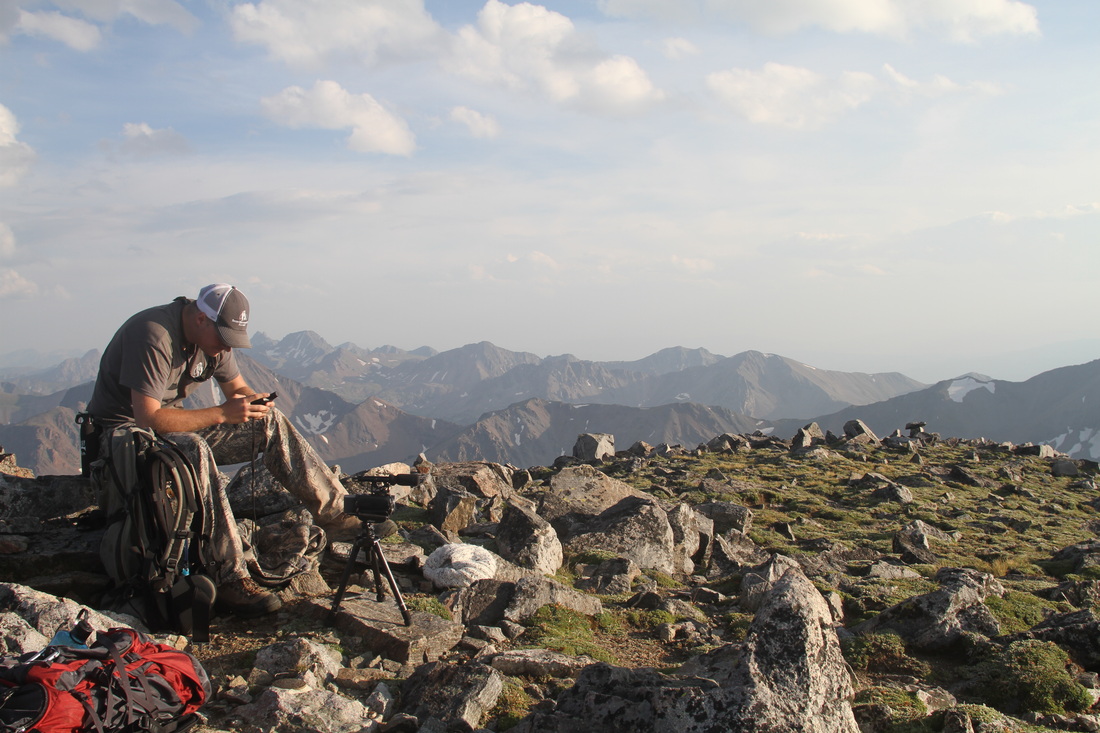
It makes sense really. Out of all ungulates, the mountain goat would have the fewest “competitors” if you will in terms of potentially encroaching on another species’ historical habitat. They live in such selective terrain with so few peers in the ability to utilise the same terrain.
Yeah, there aren’t too many species out there that can survive off lichen. They’re a fairly impressive animal in my book. They inhabit some fairly unique terrain and they’re just plain tough. They’re so eligible for introduction because they’re so robust. Mountain goats are just downright survivors. They don’t reproduce all that fast – their only downfall really – but they’re just so tough. You look at a sheep the wrong way, he dies. You look at a goat the wrong way and it looks right back at you and then just climbs higher.
You had to go and piss off all the sheep hunters didn’t you?! But you’re right. Goats are renowned for their toughness.
Yeah. They are an evolutionary anomaly. There’s no doubt about it.
Indeed, so what are the most time sensitive needs for the mountain goat in North America?
I think micro-managing some of our populations is pretty vital, so really looking at things on the smaller more localised level instead of purely big picture management. There’s not a lot, heck there’s not any research being conducted on climate change and how it affects mountain goats. That’s something that needs to be addressed sooner than later. The overharvesting of nannies is one of the biggest problems we need to address and at the most basic level we need to continually raise awareness about this animal and where and how it needs our help.
Excellent and what can hunters do to help, how can they get involved?
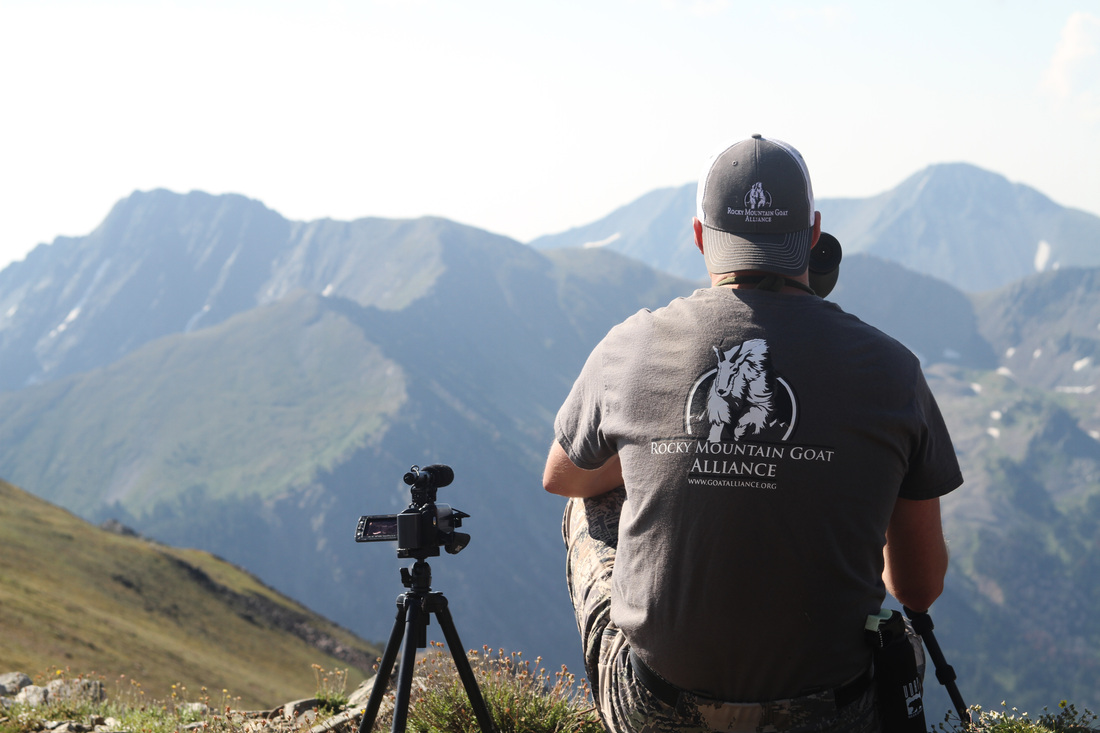
Alright, now let’s give our readers some background on Peter Muennich, the man behind the Rocky Mountain Goat Alliance. Are you Montana born and raised?
I’m not. I’m actually from Ohio. I’m from a small suburb of Ohio from a family of people who have never been hunters.
Wow, that’s remarkable!
Yeah, I’m a little bit of a wild card in the whole family bloodline I guess. I started bow hunting in the suburbs of Cincinnati when I was thirteen because I watched Tom Miranda’s hunting show on ESPN on the weekends. I came to college in Montana so I could hunt elk and got into elk hunting pretty aggressively in my college years and then that quickly led to bear hunting, then antelope hunting, and then ultimately on to sheep and goats and moose. I’ve been fortunate enough to do a lot of amazing hunting in Montana and some of the surrounding States and really took my own path to becoming such a passionate hunter.
Incredible! And what’s especially interesting about your story is there seems to be an increasing number of people becoming hunters without having been exposed to it in the traditional way, through their families.
It’s certainly evolving. We have more and more people introducing themselves to hunting. I almost want to call it trendy now with all the emphasis on the quality of the meat and he self-reliant spirit of hunting.
Alright, so as we always do to finish an interview let’s go through a couple “rapid fire” type questions. What’s your favourite species to hunt?
Mountain goats, of course!
That had better be the answer! And if you had to hunt with either a rifle or a bow for the rest of your life, what would it be?
I’d probably choose the bow. I love shooting archery.
Trad or compound?
I shoot a compound.
What was your earliest hunting memory, and this is an especially interesting question given your past!
I had a family friend of ours that took me on a squirrel hunt in Kentucky when I was maybe twelve years old. I remember sitting under a tree, shooting a squirrel and it was the first animal I ever skinned and cooked. It was 24 hours of the most full hunting experience I could have hoped for at that early stage of my hunting life. It was just a great squirrel hunt in Kentucky.
And what’s the most challenging hunt you’ve experienced?
The first deer I shot, no question. We had a family friend who had three acres in their backyard and they let me put up a tree stand which just horrified my mother. I was a sophomore in high school so I made it there at like four o’clock, climbed up into my tree stand and shot a little whitetail. I remember, I called my dad and told him I’d got one. Even though he didn’t hunt, he was still happy and proud of me but then we realised none of us knew what to do with this thing. My father had never gutted an animal. I’d never gutted an animal. My big brother who was probably seventeen at the time had never gutted an animal and probably hadn’t even touched a dead deer. So I had something like twenty pages of step-by-step instructions printed off in my backpack with me so I spent about three hours gutting this little whitetail. It was pretty funny, my poor Dad standing there holding onto these body parts but not being able to contribute anything beyond that while I flip back and forth through these pages that are starting to stick together from the blood on my hands. It was certainly memorable!
Okay last question what is your number one bucket list hunt?
I’d love to bowhunt to do a combo bowhunt for mountain goats and Stone sheep in British Columbia. I really want a BC goat. I’ve only managed to kill one mountain goat myself and he was with the rifle so it’s time to pick up the bow.
From the Editors:
Despite being such an incredibly tough and resilient animal, the Rocky Mountain goat needs our support and attention as hunters. Conservation is not merely a responsibility but an obligation of the modern hunter and becoming a member of the RMGA will help the hunting and conservation community gather much needed data and spearhead educational projects we are in desperate need of updating. Join now at www.goatalliance.org.


